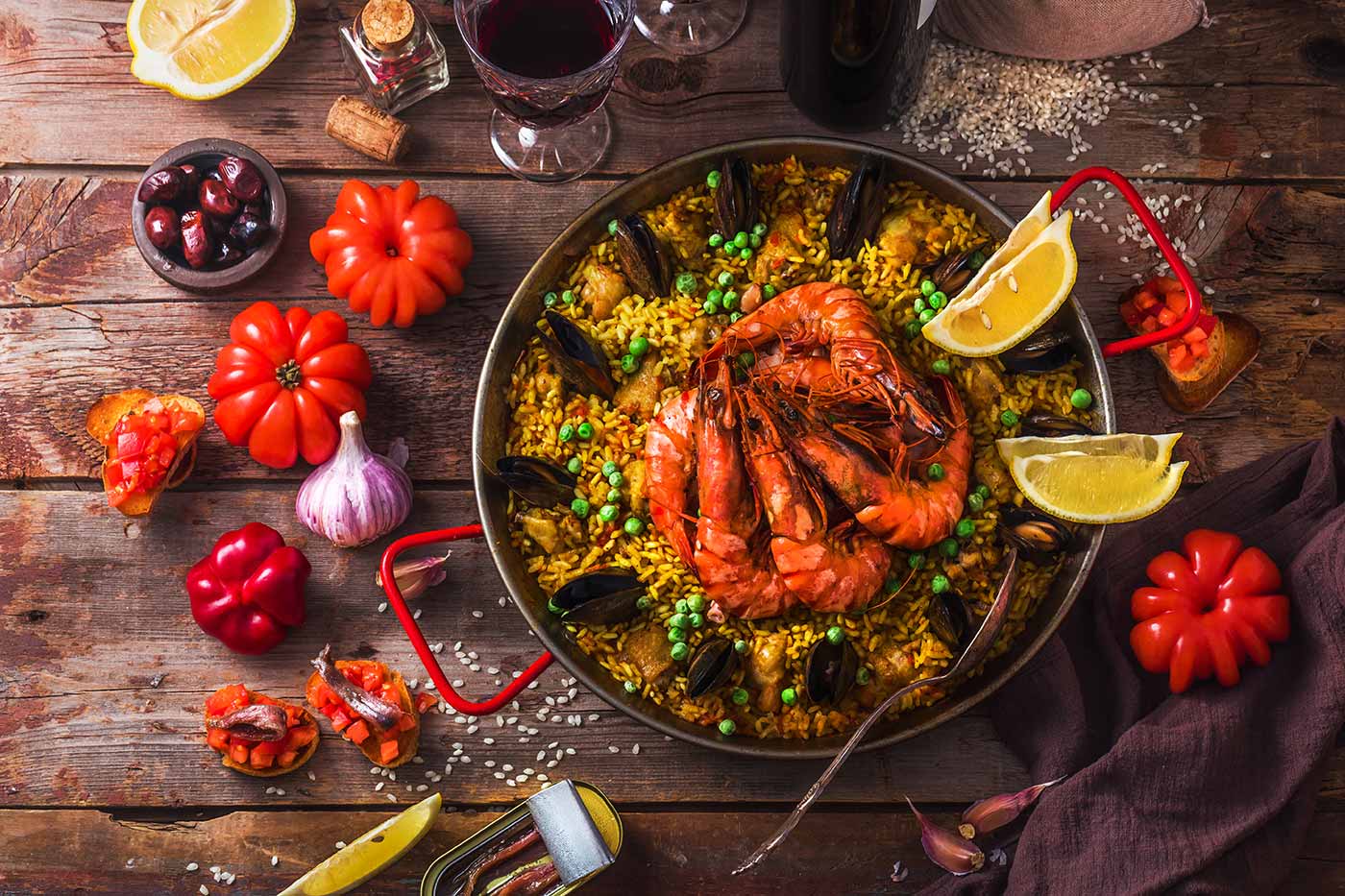Listeners:
Top listeners:
00:00
00:00
volume_up
chevron_left
-
 play_arrow
play_arrow
Costa Blanca Radio The Sound Of The Costa
-
 play_arrow
play_arrow
FeelGood Radio The Sound Of The Costa
music_note
When you think of Spain, you think of paella. But where did this iconic dish actually come from, and why are there so many different versions? In my first article here on The Sound Of The Costa, I already wrote about everything you can eat in Spain besides paella and tapas, but surprisingly, I’ve hardly touched on the country’s national dish itself. Time to set that right.
In The Ultimate Paella Guide, I’ll take you on a journey into the world of paella: from the traditional Valencian version to surprising varieties you can find along the Costa’s. Plus, I’ll share tips on what you definitely shouldn’t do when ordering paella—to avoid any embarrassing mistakes.
The origins of paella: a bit of history
Paella originated in the 18th century in the Valencia region, where it was prepared by farmers who cooked their meals over an open fire using whatever ingredients the land provided. The word ‘paella’ comes from the Latin ‘patella,’ meaning a flat pan. Originally, the dish was made with rice, vegetables, rabbit, chicken, and sometimes snails. Seafood was only added later, especially when coastal areas adopted this traditional dish and adapted it to their own local ingredients. The use of saffron, an expensive spice, not only gave paella its characteristic color but was also seen as a status symbol.
What truly makes a paella great is not just the choice of ingredients but especially the socarrat—the crispy layer at the bottom of the pan. This forms when the rice is left on the heat just long enough to caramelize without burning. According to purists, paella should always be cooked over an open fire, preferably using orange tree wood for a subtle smoky flavor.
Misconceptions about paella
Many tourists happily order a ‘paella mixta’—a mix of seafood and meat. However, in Valencia, this is considered a cardinal sin. There, you either choose a ‘paella de mariscos’ (seafood) or a ‘paella valenciana’ (meat). Mixing the two is an absolute no-go according to purists. And although many experts are aware of this, we can’t leave out one important detail in The Ultimate Paella Guide: Spaniards eat paella as a lunch dish, not for dinner.
The different types of paella on the Costa’s
Paella valenciana: The classic version with chicken, rabbit, and vegetables, typically found in the inland areas of Valencia. It is often cooked over an open fire with rosemary added for extra flavor.
Paella de mariscos: Made with shrimp, mussels, and squid, often served along the coast. Popular among those who love a pure seafood flavor without any meat.
Paella negra: Black paella made with squid ink, which not only gives it its distinctive color but also adds an intense, savory flavor. It is usually served with aioli.
Paella alicantina: A specialty of the Alicante province, featuring both meat and seafood. It is often prepared with ‘salmorreta,’ a sauce made from garlic, tomato, and ñora peppers.
Paella vegetariana: A version without meat or seafood, but rich in seasonal vegetables, bell peppers, artichokes, and saffron.
What you definitely shouldn’t do when ordering paella
The Ultimate Paella Guide wouldn’t live up to its name without a list of things to watch out for when enjoying this iconic dish.
Don’t ask for chorizo in your paella – While chorizo might seem inseparable from Spanish cuisine, adding it to paella is actually a British invention that will earn you some disapproving looks from most Spaniards. Traditional paella does not include chorizo.
Don’t order paella for one person – In Spain, paella is ordered per pan to share. It’s a social dish meant to be enjoyed together, not as an individual serving.
No lemon without permission – While some Spaniards do add lemon, purists see it as an insult to the chef. So, make sure to ask first.
Don’t stir the paella – Once the paella is ready, leave it as it is. Stirring breaks the socarrat—the crispy crust at the bottom—that is so highly prized.
Avoid paella in touristy areas – The best paella is found where the locals eat, not in places with plastic menus full of pictures.
The 3 best restaurants on the Costa’s for paella
Naturally, The Ultimate Paella Guide has to include a Top 3 of the very best paella restaurants along the Spanish coasts.
-
El Racó de l’Arròs is a restaurant in Moraira, specializing in traditional Valencian rice dishes. The menu offers a variety of paellas and fideuás, including Paella Valenciana, Arroz a banda, and Arroz negro. Guests praise the homemade, high-quality cuisine at excellent prices. The restaurant is located on Avenida de Madrid 3B in Moraira and is known for its warm and welcoming atmosphere. For the latest updates and photos, you can visit their Facebook page.
-
Rincón de Capis is a family-run restaurant in Torrevieja, specializing in both traditional and innovative dishes, with a strong focus on rice dishes like paella. In 2019, it received the award for the best tapa in the Comunidad Valenciana. The restaurant is known for its high quality and creative cuisine. Visitors praise the excellent value for money and the friendly service. This restaurant can also be found on Facebook.
- Los Mellizos Marbella is a restaurant on the Paseo Marítimo in Marbella, specializing in fresh seafood and traditional Andalusian dishes. The restaurant is known for its extensive selection of rice dishes, including various paella options. Guests appreciate the high quality of the food and the seafront location. In addition to an Instagram profile, the restaurant also has its own website.
Paella: more than just a meal
Paella is more than just a dish; it’s a social ritual. Spaniards take their time to eat together, sharing from the same pan. It’s not just about the food, but about being together.
Salud y buen provecho!
Call for entries: Your favorite restaurant as ‘Restaurant of the Month’!
After Isla Bali, we at The Sound Of The Costa are looking for the best and most-loved restaurants to review, put in the spotlight, and feature in a giveaway. Do you have a tip for an amazing restaurant on the Costa’s? An announcement will be posted soon on our Facebook page and Instagram account. Follow us there, stay updated, and share your favorite restaurant with us!
Written by: Wouter van der Laan
best paella Costa dining at the Costa paella etiquette paella in Spain paella recipes paella restaurants paella tips paella Valencia rice dishes Spain Spanish cuisine Spanish rice dishes traditional paella
Rate it
Similar posts
Search
Latest news

Aliats: Wings, balance and the future of sustainable wine

Sunday begins with vino: how wine became a natural ritual

The ancient wine routes of Spain – from amphora to wine trail

Winemaking with character: how architecture reveals the soul of the bodega

Superfood or sweet excuse? What grapes and wine really bring us
-
Recent Posts
- Aliats: Wings, balance and the future of sustainable wine
- Sunday begins with vino: how wine became a natural ritual
- The ancient wine routes of Spain – from amphora to wine trail
- Winemaking with character: how architecture reveals the soul of the bodega
- Superfood or sweet excuse? What grapes and wine really bring us
© 2025 The Sound Of The Costa; All Rights Reserved



